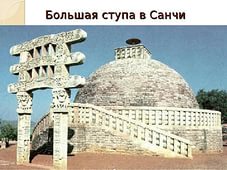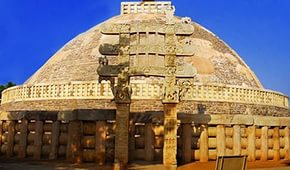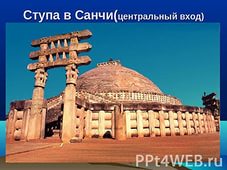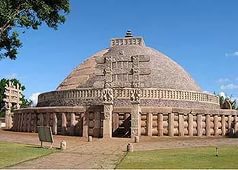The Buddhist vihara at Sanchi, famous for its Great Stupa is located at Sanchi Town in Raisen District of the state of Madhya Pradesh, India, it is located 46 km north-east of Bhopal.
The Great Stupa at Sanchi is the oldest stone structure in India[1] and was originally commissioned by the emperor Ashoka the Great in the 3rd century BCE. Its nucleus was a simple hemispherical brick structure built over the relics of the Buddha. It was crowned by the chatra, a parasol-like structure symbolising high rank, which was intended to honour and shelter the relics. The construction work of this stupa was overseen by Ashoka's wife, Devi herself, who was the daughter of a merchant of Vidisha. Sanchi was also her birthplace as well as the venue of her and Ashoka's wedding. In the 1st century BCE, four elaborately carved toranas (ornamental gateways) and a balustrade encircling the entire structure were added.
Ashoka's Pillar (broken)
The 'Great Stupa' at Sanchi is the oldest structure and was originally commissioned by the emperor Ashoka the Great in the 3rd century BCE. Its nucleus was a hemispherical brick structure built over the relics of the Buddha. It was crowned by the chatra, a parasol-like structure symbolising high rank. A pillar of finely polished sandstone was also erected. The old stupa was later covered when it was expanded. The bottom part of the pillar still stands. The upper parts of the pillar are placed under a canopy nearby. The pillar has an Ashokan inscription (Schism Edict) and an inscription in the ornamental Sankha Lipi from the Gupta period.
Shunga period
The compound Buddhist symbols: Shrivatsa within a triratana, over a Chakra wheel, on the Torana gate at Sanchi.
The original brick stupa was later covered with stone during the Shunga period. On the basis of Ashokavadana, it is presumed that the stupa may have been vandalized at one point sometime in the 2nd century BCE, an event some have related to the rise of the Shunga emperor Pushyamitra Shunga who overtook the Mauryan Empire as an army general. It has been suggested that Pushyamitra may have destroyed the original stupa, and his son Agnimitra rebuilt it.[2] During the later rule of the Shunga, the stupa was expanded with stone slabs to almost twice its original size. The dome was flattened near the top and crowned by three superimposed parasols within a square railing. With its many tiers it was a symbol of the dharma, the Wheel of the Law. The dome was set on a high circular drum meant for circumambulation, which could be accessed via a double staircase. A second stone pathway at ground level was enclosed by a stone balustrade with four monumental gateways (toranas) facing the cardinal directions. The buildings which seem to have been commissioned during the rule of the Shungas are the Second and Third stupas (but not the highly decorated gateways, which are from the following Satavahana period, as known from inscriptions), and the ground balustrade and stone casing of the Great Stupa.
The gateways and the balustrade were built and colored, then appeared to have been commissioned by the Satavahana. An inscription records the gift of one of the top architraves of the Southern Gateway by the artisans of the Satavahana king Satakarni:
- "Gift of Ananda, the son of Vasithi, the foreman of the artisans of rajan Siri Satakarni".[3]
DC Sircar observes that palaeographically the Hathigumpha record is slightly later than Naneghat record whereas the letters of Sanchi inscription of Satakarni resemble the script of Hathigumpha inscription. Kharavela in his inscription mentions one Satakarni, who is identified as Satakarni II, who is also identical to the one who inscribed in Sanchi. If this is true, then the dating of Sanchi gateway and balustrade belong to the much earlier period of 180-160 BC.
Although made of stone, they were carved and constructed in the manner of wood and the gateways were covered with narrative sculptures. They showed scenes from the life of the Buddha integrated with everyday events that would be familiar to the onlookers and so make it easier for them to understand the Buddhist creed as relevant to their lives. At Sanchi and most other stupas the local population donated money for the embellishment of the stupa to attain spiritual merit. There was no direct royal patronage. Devotees, both men and women, who donated money towards a sculpture would often choose their favourite scene from the life of the Buddha and then have their names inscribed on it. This accounts for the random repetition of particular episodes on the stupa (Dehejia 1992). On these stone carvings the Buddha was never depicted as a human figure. Instead the artists chose to represent him by certain attributes, such as the horse on which he left his father’s home, his footprints, or a canopy under the bodhi tree at the point of his enlightenment. The human body was thought to be too confining for the Buddha.
Some of the friezes of Sanchi also show devotees in Greek attire (Greek clothing, attitudes, and musical instruments) celebrating the stupa.Further stupas and other religious Buddhist structures were added over the following centuries until the 12th century AD. Temple 17 is probably one of the earliest Buddhist temples as it dates to the early Gupta period. It consists of a flat roofed square sanctum with a portico and four pillars. The interior and three sides of the exterior are plain and undecorated but the front and the pillars are elegantly carved, giving the temple an almost ‘classical’ appearance (Mitra 1971). Temple 45 was the last Buddhist temple built during the mid - late 9th century.[5] Also at this time the monuments were enclosed within a wall. With the decline of Buddhism in India, the monuments of Sanchi went out of use and fell into a state of disrepair. In 1818, General Taylor of the Bengal Cavalry recorded a visit to Sanchi. At that time the monuments appear to have been left undisturbed for a long time and in generally good preservation
A British officer in 1818, General Taylor, was the first known Western historian to document (in English) the existence of Sanchi (Sāñcī). Amateur archaeologists and treasure hunters ravaged the site until 1881, when proper restoration work was initiated. Between 1912 and 1919 the structures were restored to their present condition under the supervision of Sir John Marshall.[6]
Today, around fifty monuments remain on the hill of Sanchi, including three stupas and several temples. The monuments have been listed among the UNESCO World Heritage Sites since 1989.
The bone relics (dhatu) of Buddhist Masters along with the reliquaries, obtained by Maisey and Cunningham were divided by them and taken to England as personal trophies.[7] Maisey's family sold the objects to Victoria and Albert Museum where they stayed for a long time. The Buddhists in England, Sri Lanka and India, lead by the Mahabodhi Society demanded that they be returned. Some of the relics of Sariputta and Moggallana were sent back to Sri Lanka, where they were publicly displayed in 1947.[8] Almost entire population of Sri Lanka visited them. They were later returned to India. A new temple Chetiyagiri Vihara was constructed to house the relics, in 1952.[9] In a nationalistic sense, this marked the formal reestablishment of the Buddhist tradition in India. Some of the relics were obtained by Burma.[10]
Sanchi, especially Stupa 1, has a large number of Brahmi inscriptions. Although most of them are small and mention donations, they are of great historical significance. James Prinsep in 1837, noted that most of them ended with the same two Brahmi characters. Princep took them as "danam" (donation), which permitted the decipherment of the Brahmi script,.[11][12]
An analysis of the donation records [13] shows that while a large fraction of the donors were local (with no town specified), a number of them were from Ujjain, Vidisha, Kurara, Nadinagar, Mahisati, Kurghara, Bhogavadhan and Kamdagigam.
The inscriptions include those from Maurya, Shunga/Satavahana (175 BC-15 AD), Kushana (100-150 AD), Gupta (600-800 AD, see Sanchi inscription of Chandragupta II). The Ye Dharma Hetu inscription in Temple 45 may be dated to 9th century.















